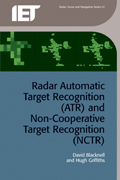- Agricultural Engineering and Technology
- Applied Physics
- Built Environment
- Computing and Networks
- Control, Robotics and Sensors
- Electrical Regulations
- Electromagnetics and Radar
- Energy Engineering
- Healthcare Technologies
- History and Management of Technology
- IET Codes and Guidance
- Manufacturing
- Materials, Circuits and Devices
- Model Forms
- Security
- Telecommunications
- Transportation

Radar Automatic Target Recognition (ATR) and Non-Cooperative Target Recognition (NCTR)
Edited by David Blacknell, Hugh Griffiths
The ability to detect and locate targets by day or night, over wide areas, regardless of weather conditions has long made radar a key sensor in many military and civil applications. However, the ability to automatically and reliably distinguish different targets represents a difficult challenge. Radar Automatic Target Recognition (ATR) and Non-Cooperative Target Recognition (NCTR) captures material presented in the NATO SET-172 lecture series to provide an overview of the state-of-the-art and continuing challenges of radar target recognition.
Topics covered include the problem as applied to the ground, air and maritime domains; the impact of image quality on the overall target recognition performance; the performance of different approaches to the classifier algorithm; the improvement in performance to be gained when a target can be viewed from more than one perspective; the impact of compressive sensing; advances in change detection; and challenges and directions for future research.
Radar Automatic Target Recognition (ATR) and Non-Cooperative Target Recognition (NCTR) explores both the fundamentals of classification techniques applied to data from a variety of radar modes and selected advanced techniques at the forefront of research, and is essential reading for academic, industrial and military radar researchers, students and engineers worldwide.
About the Editors
David Blacknell is currently a Dstl Fellow and a visiting Professor at University College London. He has worked on a large variety of topics in radar signal and image processing during his career which has included senior technical roles at DERA, QinetiQ, and Cranfield University. He is a recognised international expert on radar image exploitation and has been the recipient of two CSA commendations for contributions to Defence Science and Technology.
Hugh Griffiths holds the THALES/Royal Academy Chair of RF Sensors in the Department of Electronic and Electrical Engineering at University College London, UK, and serves as President of the IEEE AES Society for 2012/13, as Editor-in-Chief of the IET Radar, Sonar & Navigation journal, and as a member of the Defence Scientific Advisory Council for the UK Ministry of Defence. In 2012 he was awarded the A F Harvey Engineering Research Prize by the IET.
Publication Year: 2013
Pages: 296
ISBN-13: 978-1-84919-685-7
Format: HBK
Editors: David Blacknell, Hugh Griffiths
